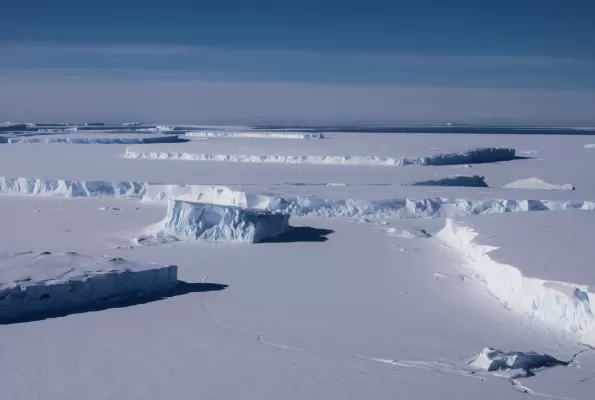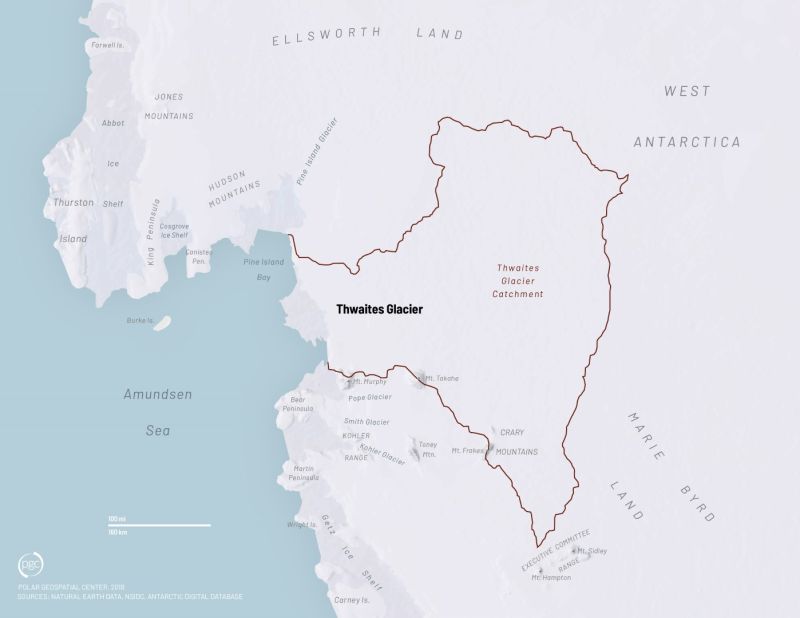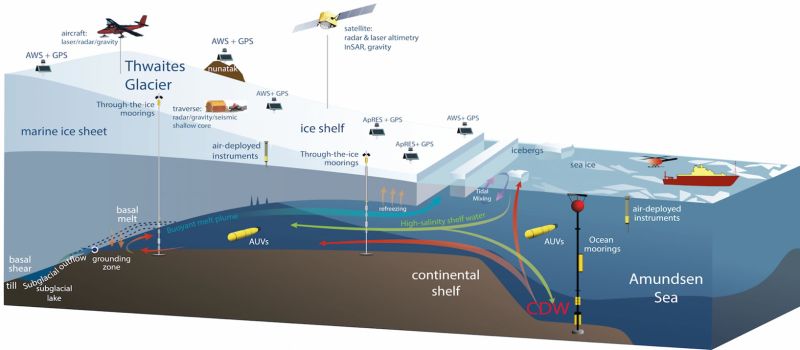
The glacier of greatest concern
Antarctica’s massive Thwaites Glacier is melting because of climate change, and a collapse of the glacier could raise sea levels significantly around the world.
To glaciologists, it’s “the glacier of greatest concern” and the focus of the largest-ever joint U.S.-U.K. Antarctic field research program - the International Thwaites Glacier Collaboration. The U.S. National Science Foundation and the U.K. Natural Environment Research Council have teamed up to send scientists to the remote region by land, sea and air to study every aspect of the glacier and better predict how it will impact the world’s coastlines in the coming decades and centuries.
“It’s not ‘If sea level is going to go up’-- it’s ‘When and how much,’” said Erin Pettit of Oregon State University, one of the principal investigators on the Thwaites-Amundsen Regional Survey and Network Integrating Atmosphere-Ice-Ocean Processes project, a part of the International Thwaites Glacier Collaboration. “The Thwaites project is focused specifically on the sea level rise question and trying to narrow down that.”
Since the year 2000, more than 1 trillion tons of the glacier’s ice has melted into the ocean, and the speed of the ice loss has been accelerating. So far, the glacier has contributed only a few millimeters to global sea level rise, but scientists worry that if the whole West Antarctic ice sheet collapses, levels could rise significantly more.
“There’s been a lot of work in the last several years emphasizing the potential instability of Thwaites Glacier and its drainage basin, which contains up to one meter of sea level rise in it,” said Slawek Tulaczyk of the University of California, Santa Cruz, one of the principal investigators on the Thwaites Interdisciplinary Margin Evolution project.
A complete collapse of the Florida-sized glacier would likely take hundreds of years, but even a partial collapse could raise sea levels enough to seriously disrupt coastal population centers worldwide. It could also accelerate the rate of sea level rise, making it difficult to plan and manage the world’s coastlines and ports.
“The concern is that this glacier is large enough and centrally located within West Antarctica that, by itself, it represents a significant risk to increase sea level, possibly before the end of this century,” said Ted Scambos, a glaciologist at the University of Colorado Boulder and co-lead of the Science Coordination Office of the International Thwaites Glacier Collaboration.
However, precise predictions about the glacier’s future are difficult because there are numerous lingering questions about the current state of Thwaites Glacier, and reaching the ice mass itself is no easy matter. It resides in a remote region of West Antarctica, many hundreds of miles from the nearest research station.
To get at some of these answers and better predict how much and how fast the glacier is likely to contribute to global ocean levels, NSF’s U.S. Antarctic Program is teaming up with the U.K. Natural Environment Research Council’s British Antarctic Survey in a major effort to support the study of Thwaites Glacier up close. Over multiple Antarctic research seasons, joint U.S. and U.K. field teams are traveling to the remote region to peer deep into every aspect of the glacier. The teams also collaborate with scientists from South Korea, Sweden, Germany, Norway, Finland and France.
“It’s a whole set of projects … kind of under, over, around and through the Thwaites Glacier region,” Scambos said. “A major and coordinated program was needed to get the most out of everybody’s research.”
Six field teams are traveling to numerous sites over the next few years on and around the glacier to understand what’s going on at the glacier now and what happened in the past. The data they’re collecting are helping the collaboration’s two modeling teams to develop long-term predictions that better pin down how much sea level rise the planet is facing in the coming decades to centuries.
Because climate change is causing ocean currents to shift, warm ocean water that would usually circulate far from the Antarctic Coast has been making its way underneath the glacier, melting it out from below. What makes Thwaites of particular concern is that the point where the ice meets the sea is perched precariously on an underwater ridge with a large subglacial trough behind it.
Scientists fear that, if the underside of the glacier melts back far enough and warm water breaches that ridge, it could start eroding the ice that fills the trough, leading to faster retreat and speeding its flow into the ocean.
If this melting happens, computer models suggest that such a breach could trigger a dramatic collapse of the glacier.
“That step right there makes the whole coastline around Thwaites vulnerable to melting. It’s all shown signs of melting and thinning, but for Thwaites in particular, this unfortunate geographic setting means that it’s the one that can really unleash the genie,” Scambos said.
Getting enough researchers to the remote region is a major effort. Working together over multiple years, the U.S. Antarctic Program and British Antarctic Survey first staged thousands of tons of scientific instruments, field equipment and other supplies for researchers and support staff to use in the field. To deliver everything, it took dozens of flights from both U.S. and U.K. research stations, as well as multiple tractor traverses over hundreds of miles of rough Antarctic terrain, and an ocean delivery to the edge of the ice shelf by the RRS Earnest Shackleton and Her Majesty's Ship Protector.
The first of the International Thwaites Glacier Collaboration researchers traveled to the glacier in late 2018, with more venturing there the following year and another set of expeditions planned for the coming years, including on the U.S. Antarctic Program’s vessel the Nathaniel B Palmer and the South Korean vessel Araon. Though the pandemic has delayed work in the Antarctic, the teams are analyzing the data already collected over their two previous field seasons. At the same time, researchers and computer modelers are working to improve models that will predict with greater certainty what will happen to the glacier in the coming decades and centuries as it continues to recede.
“By working together across the eight large projects within the International Thwaites Glacier Collaboration, and with the broader scientific community, ITGC will best serve its goal of sharpening the forecast of Thwaites Glacier’s potential contribution to rising sea level,” said Paul Cutler, program director for Glaciology, Ice Core Science, & Geomorphology in NSF’s Antarctic Sciences section.






